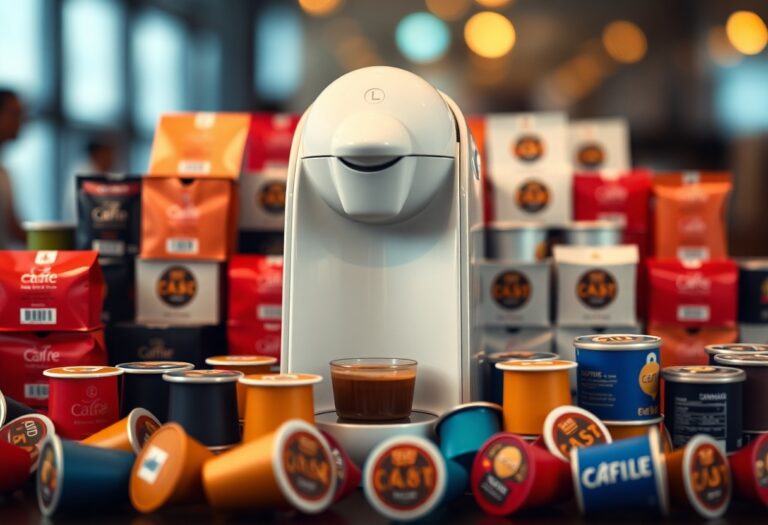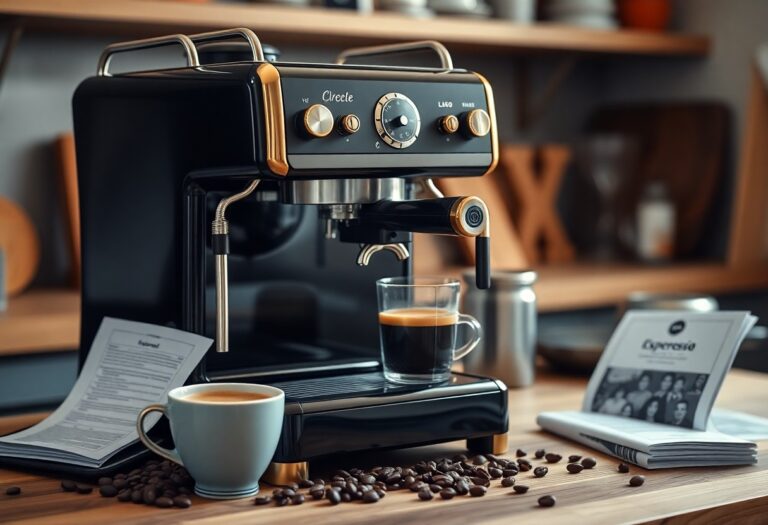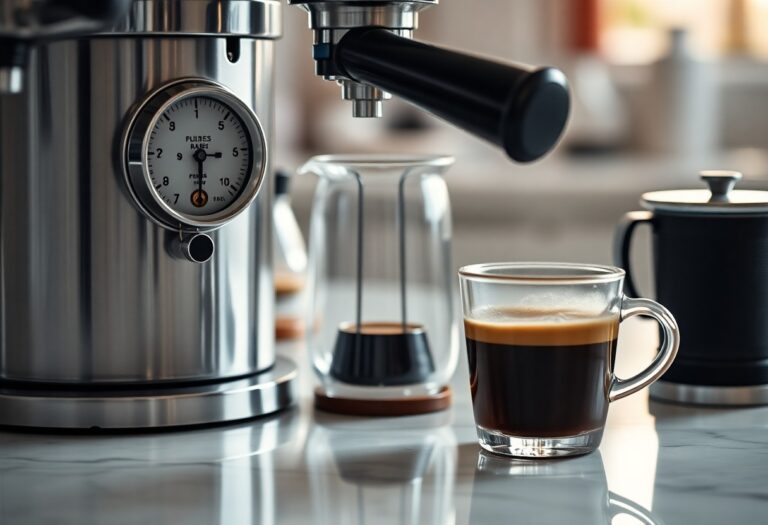What is a Semi-Automatic Coffee Machine – Manual Control
It’s crucial to understand the features of a semi-automatic coffee machine, especially if you want to elevate your home brewing experience. This type of machine allows you to have manual control over key brewing variables, including water flow and pressure, giving you the power to customize your coffee just the way you like it. While you can enjoy a superb cup of coffee, the added complexity may present a learning curve, making it vital to master your technique. Dive in to discover how to harness the full potential of your semi-automatic coffee machine!

Key Takeaways:
- Semi-automatic coffee machines require the user to control the brewing process, offering a balance between automation and manual involvement.
- These machines typically include a built-in grinder, allowing users to grind beans fresh for each brew, enhancing flavor and aroma.
- User input is imperative for parameters such as water temperature and brewing time, enabling coffee enthusiasts to tailor their brew to their preferences.
- Maintenance of semi-automatic machines often involves routine cleaning and descaling to ensure optimal performance and longevity.
- They are suitable for both beginners and experienced coffee lovers who want to explore the art of espresso-making without fully manual processes.
The Anatomy of a Semi-Automatic Coffee Machine
Semi-automatic coffee machines consist of various components that work together to create a delicious cup of coffee. By blending the necessary pressure, temperature, and extraction time, these machines enable you to craft espresso just like a barista. Understanding these parts helps you appreciate the intricacies involved in brewing your perfect cup and how each component plays a critical role in executing your desired flavors.
Key Components That Make the Magic Happen
Key components of semi-automatic coffee machines include the boiler, which generates steam and hot water; the portafilter, where you place the ground coffee; and the pump, responsible for creating the pressure necessary for extraction. Additionally, the group head connects the portafilter to the machine, ensuring even water distribution over the coffee grounds and optimal flavor extraction.
How Manual Control Elevates the Brewing Experience
Manual control in semi-automatic machines offers you the flexibility to adjust various brewing parameters, such as water flow and extraction time. This empowers you to experiment with different coffee types and grind levels, tailoring each brew to your unique taste preferences. You gain insight into how adjustments impact flavor, enabling a deeper connection to the brewing process and encouraging creativity in your coffee-making journey.
With manual control, you take charge of the extraction process that significantly influences the coffee’s flavor profile. Adjusting extraction times can enhance sweetness or acidity, while varying pressure can unlock a coffee’s hidden nuances. By learning to manipulate these elements, you’re not just brewing coffee; you become an artisan, engaging in a rich dialogue with the coffee itself. Each adjustment you make informs your understanding of flavors and aromas, inspiring a personalized brewing experience that elevates your appreciation for this beloved beverage.
Harnessing Manual Control: The Art of Brewing
Mastering a semi-automatic coffee machine invites you into the art of brewing, where you are both the artist and the craftsman. With every squeeze of the lever, every tweak of the settings, you unlock a universe of flavors and aromas. Semi-automatic machines allow you to exert Unlock the Power of Espresso with a Semi-Automatic coffee machine, making each cup uniquely yours. The journey of brewing becomes a personal expression of taste, highlighting your creativity and preferences.
Precise Control Over Pressure and Temperature
Achieving a great espresso is about fine-tuning pressure and temperature during extraction. Below is a breakdown of these imperative elements:
| Element | Detail |
| Pressure | Typical range: 9-10 bars; influences flavor and crema |
| Temperature | Optimal range: 90-96°C; affects extraction speed and taste |
The Importance of Grind Size and Tamping Techniques
Grind size and tamping technique significantly impact the extraction process and the resultant flavor profile. A fine grind can increase surface area for extraction, enhancing flavor richness; however, too fine a grind can lead to over-extraction and bitterness. Similarly, tamping affects water flow through the coffee grounds—uneven tamping results in channeling, leading to inconsistent brewing. Aim for a firm, even pressure when tamping your coffee to achieve the perfect shot.
Often overlooked, these elements are fundamental in the art of brewing espresso. For instance, a finer grind will yield a richer, fuller-bodied espresso, while a coarser grind creates a milder taste. The goal is to achieve a consistent grind and uniform tamping—both of which create resistance, forcing water to extract flavors evenly. Take your time, experiment with grind sizes, and analyze the outcome for a tailored brewing experience that resonates with your palate.
The Taste Test: How Manual Control Transforms Flavor
With manual control, you have the ability to adjust brewing variables such as water temperature and extraction time, resulting in a coffee that reflects your unique taste preferences. This direct involvement in the brewing process allows for a more pronounced expression of flavors, whether you’re aiming for a bold espresso or a brighter filter coffee. Fine-tuning these aspects can elevate your brew to extraordinary levels, enabling you to explore the intricate tasting notes locked within each bean.
Exploring the Influence of Variables on Coffee Quality
Your choices in coffee brewing variables significantly impact the final cup. Factors like grind size, water temperature, and brew time dictate the extraction process, ultimately influencing the balance of acidity, sweetness, and bitterness in your coffee. For instance, a finer grind and longer extraction can yield a rich and syrupy result, while coarser grounds with shorter extraction time may lead to a lighter and more floral flavor profile. Each modification opens new possibilities in your pursuit of the perfect cup.
Comparing Semi-Automatic with Fully Automatic Machines
In coffee machines, semi-automatic units give you the upper hand in customization when compared to fully automatic machines. While fully automatic setups offer the convenience of a one-button operation, they lack the depth of control found in semi-automatic models. This ability to adjust various brewing parameters allows you not only to explore a spectrum of flavor possibilities but also to hone your personal coffee-making skills. In contrast, automatic machines generally adhere to predetermined settings, potentially limiting your experience.
Comparison of Semi-Automatic and Fully Automatic Machines
| Feature | Semi-Automatic |
|---|---|
| Control Over Brewing Variables | High – You adjust grind size, water temperature, and extraction time. |
| Convenience | Moderate – Requires manual intervention, but allows for customization. |
| Skill Development | Encourages learning and experimentation in coffee brewing. |
| Flavor Exploration | Broad – Enables a range of flavors based on personal adjustments. |
The depth of customization found in semi-automatic machines invites you to initiate on a journey of flavor exploration that is often stifled in fully automatic machines. Embracing this hands-on approach provides not just better flavor profiles, but it also nurtures the skills necessary to master the art of coffee brewing. By crafting each cup yourself, you develop an intimate understanding of what makes your coffee experience unique, allowing you to appreciate the subtleties in every sip.
Further Analysis of Automated Systems
| Feature | Fully Automatic |
|---|---|
| Control Over Brewing Variables | Low – Typically features preset programs for brewing. |
| Convenience | High – One-button operation for ease of use. |
| Skill Development | Limited – Less involvement in the brewing process. |
| Flavor Exploration | Narrow – Flavor profiles are predetermined by the machine. |

Maintenance and Longevity: Keeping Your Machine in Top Shape
Ensuring the longevity of your semi-automatic coffee machine hinges on regular maintenance. A well-cared-for machine not only improves the quality of your brews but also saves you from costly repairs down the line. Daily, weekly, and monthly cleaning routines will promote optimal performance, allowing you to enjoy your coffee experience without interruption. This commitment to maintenance can easily extend the life of your machine, making it a worthwhile endeavor.
Essential Cleaning and Care Tips
Incorporating a few simple habits into your routine can significantly enhance your machine’s lifespan. Regularly perform these actions:
- Deep clean the brew group weekly to remove coffee oils.
- Use a descaling solution monthly to prevent mineral buildup.
- Wipe down the exterior daily to maintain its appearance.
- Replace water filters as recommended to ensure great water quality.
This proactive approach leads to a more enjoyable coffee experience.
Troubleshooting Common Issues with Semi-Automatic Machines
Even the best machines can encounter issues that may disrupt your brewing routine. Common problems include inconsistent temperature control, grinding inconsistencies, and water leakage. Each of these challenges can hinder your coffee-making experience, so addressing them quickly is paramount. Checking connections, adjusting the grind size, and ensuring adequate water supply can often rectify these issues promptly.
Temperature fluctuations are one of the most commonly faced issues with semi-automatic machines, and they can often stem from improper settings or a malfunctioning thermostat. For grinding inconsistencies, ensure your beans are fresh and adjust your grinder settings to find the perfect extraction. If water leakage occurs, inspect the hose and fittings for wear and tear, replacing parts as necessary. Understanding your machine’s quirks will empower you to troubleshoot effectively, leading to better, more satisfying brews.
The Community: Connecting with Fellow Coffee Enthusiasts
Engaging with fellow coffee enthusiasts can amplify your semi-automatic brewing experience, providing you with valuable tips and insights. Local meetups or coffee festivals are great avenues to share your passion, while virtual platforms offer diverse opportunities for connection with global coffee lovers. Forming bonds over shared experiences can elevate your skills and introduce you to new brewing methods, enhancing both your knowledge and your appreciation for the craft.
Online Forums and Resources for Semi-Automatic Users
Online forums serve as vibrant hubs for semi-automatic coffee machine users, brimming with advice, troubleshooting tips, and recipe sharing. Platforms like Reddit or dedicated coffee community websites cultivate discussions about everything from optimal brewing temperatures to machine maintenance. These resources enrich your understanding by connecting you with experienced baristas and hobbyists who share their hard-won expertise, ensuring you maximize the potential of your machine.
The Role of Barista Skills in Building Community
Barista skills can significantly enhance your connection with the coffee community, as they provide a foundation for sharing experiences and techniques. As you gain expertise in brewing methods, latte art, and flavor profiles, you contribute to the collective knowledge of fellow coffee lovers. Hosting workshops or participating in barista competitions not only hones your skills but also fosters friendships built on a shared love for coffee craftsmanship.
Your journey in developing barista skills opens up numerous channels for community engagement. Participating in local barista competitions presents opportunities to showcase your talent and connect with industry professionals, while simultaneously encouraging others to share their stories and experiences. Leveraging social media also allows you to display your creations and solicit feedback, creating a rich tapestry of shared learning. As you engage in these experiences, you naturally cultivate connections with others who share your dedication to the art of coffee-making.
Final Words
Upon reflecting on the semi-automatic coffee machine with manual control, you understand its blend of convenience and craftsmanship. This type of machine empowers you to take charge of the brewing process, allowing for precise adjustments based on your preference. With the ability to control water temperature, extraction time, and pressure, you can achieve a coffee experience that caters to your taste. Investing time in learning the features and techniques will elevate your coffee-making skills, ensuring every cup is tailored to your liking.
FAQ
Q: What is a semi-automatic coffee machine with manual control?
A: A semi-automatic coffee machine with manual control is a type of espresso maker that allows users to manually control the brewing process. It combines elements of automation with user intervention, enabling coffee enthusiasts to adjust variables such as extraction time, water temperature, and pressure to suit their preferences. While the machine manages certain technical aspects, the user has the flexibility to override automated functions, resulting in a more personalized brewing experience.
Q: What are the advantages of using a semi-automatic coffee machine?
A: Semi-automatic coffee machines offer several benefits, including the ability to fine-tune the brewing process to achieve the desired flavor profile. Users can control variables such as grind size, tamping pressure, and extraction time to create custom espresso shots. Additionally, these machines often provide a balance between ease of use and hands-on experience, making them suitable for both beginners and experienced baristas who appreciate crafting their coffee.
Q: How does a semi-automatic coffee machine differ from fully automatic and manual machines?
A: Semi-automatic machines differ from fully automatic machines in that they require user input for certain steps, such as starting and stopping the extraction. Fully automatic machines handle these tasks without user intervention, which can be convenient but limits customization. On the other hand, manual machines provide complete control over the brewing process but require more skill and practice to master. Semi-automatic machines strike a balance between automation and user involvement.
Q: What skills do I need to operate a semi-automatic coffee machine effectively?
A: Operating a semi-automatic coffee machine effectively requires a basic understanding of espresso-making techniques. Users should learn how to properly grind coffee beans, tamp the coffee grounds, and adjust brewing parameters such as water temperature and extraction time. Familiarity with the specific machine is also important, as it may have unique features and settings that require practice to operate proficiently.
Q: Can I make different types of coffee beverages with a semi-automatic coffee machine?
A: Yes, a semi-automatic coffee machine is versatile and can be used to prepare various coffee beverages. In addition to espresso, users can steam and froth milk for lattes and cappuccinos, brew Americanos, and make macchiatos by controlling the amount of milk used. The ability to manually control brewing variables also allows users to experiment with different flavors and styles, catering to their coffee preferences.







